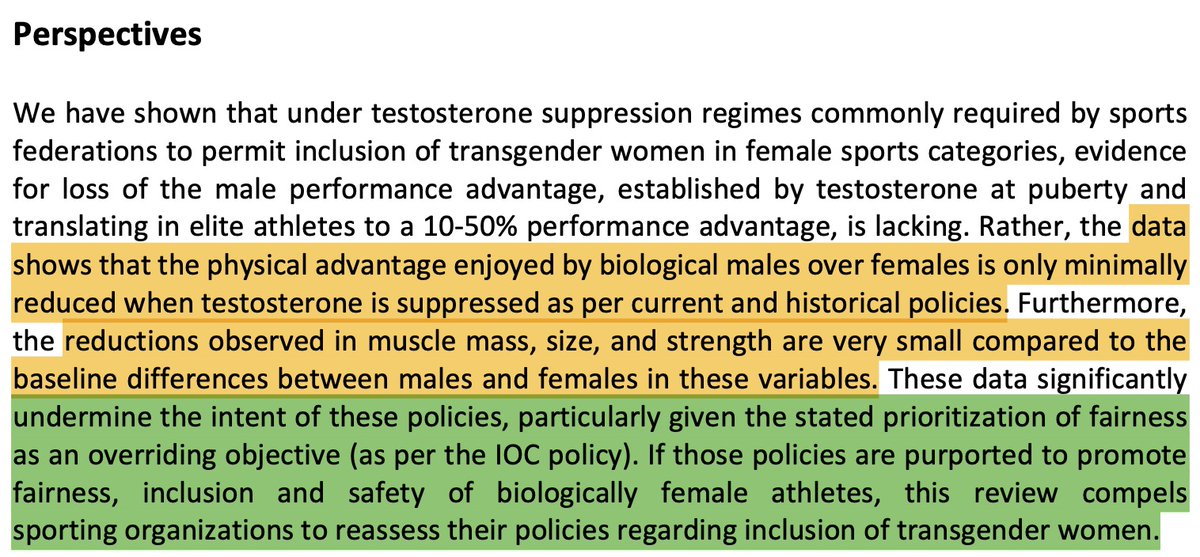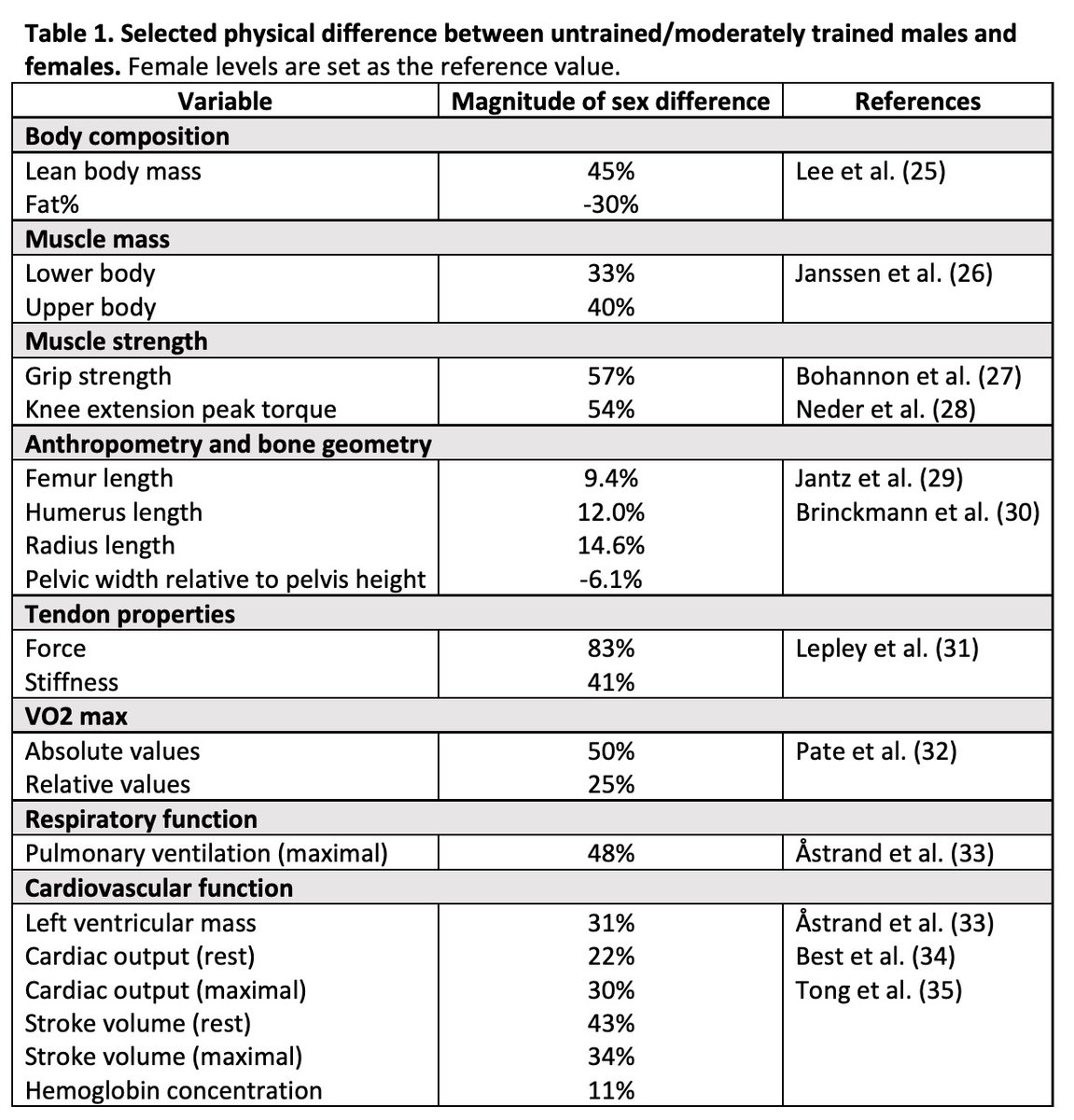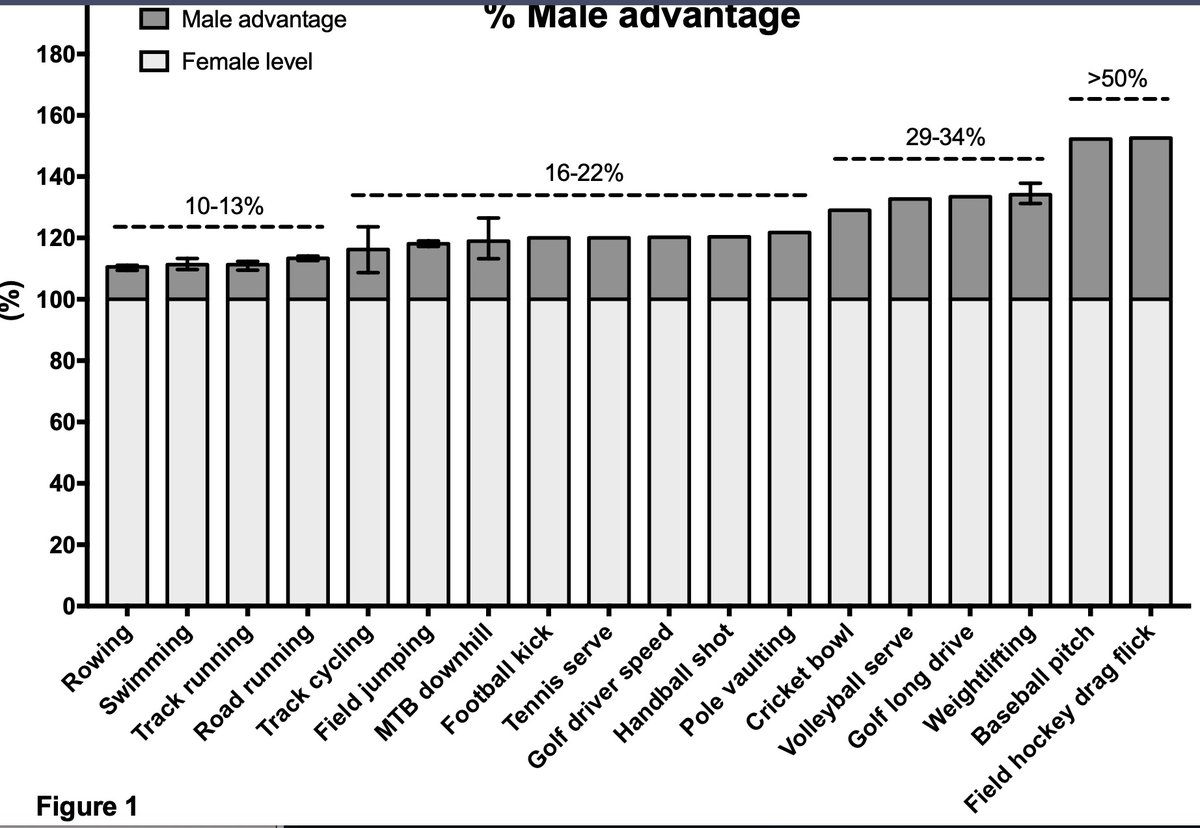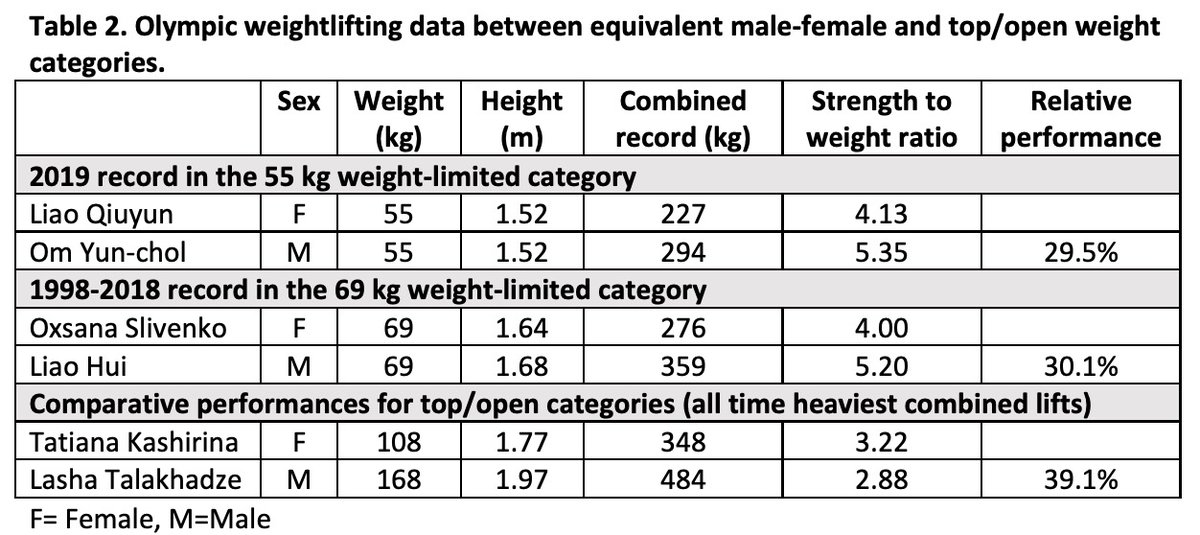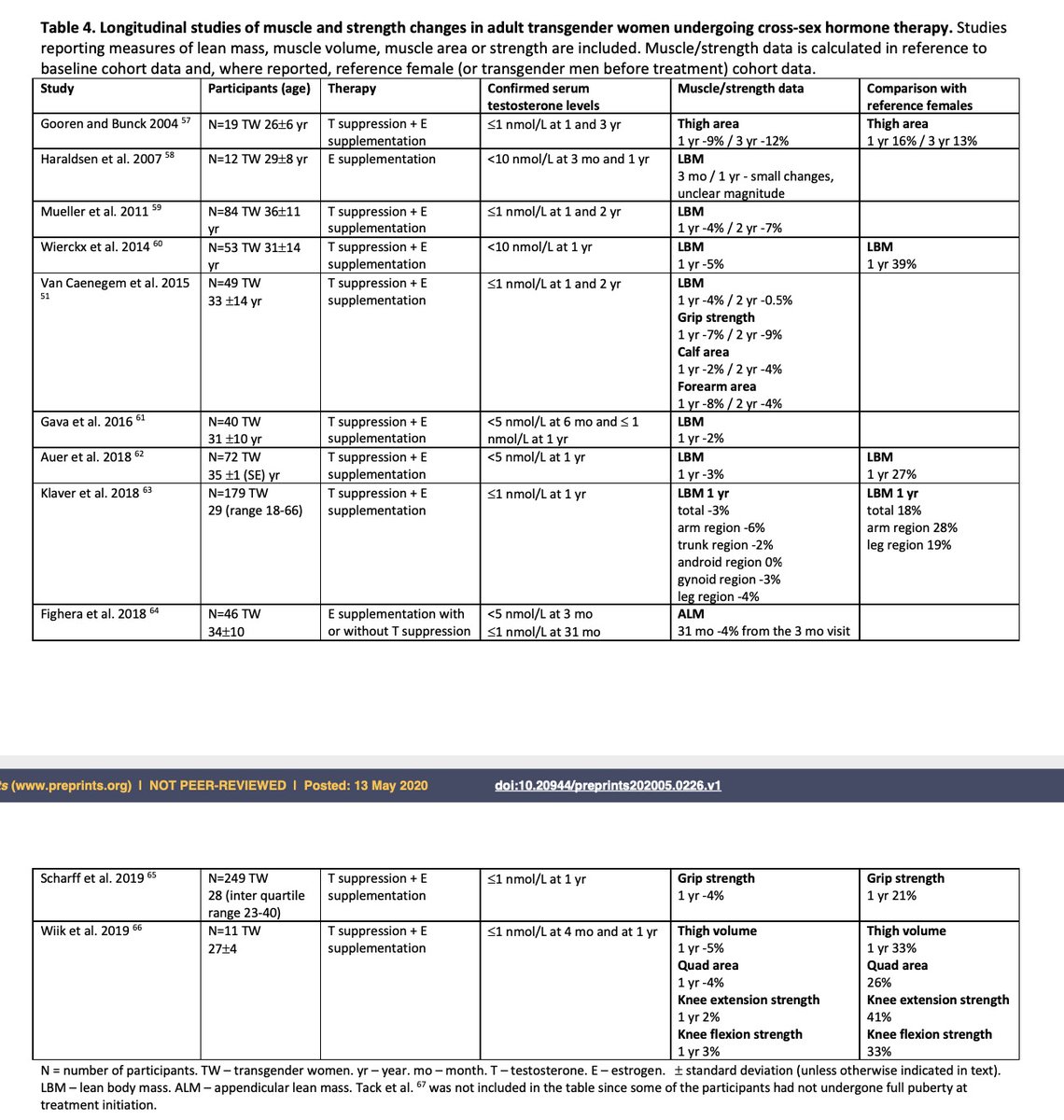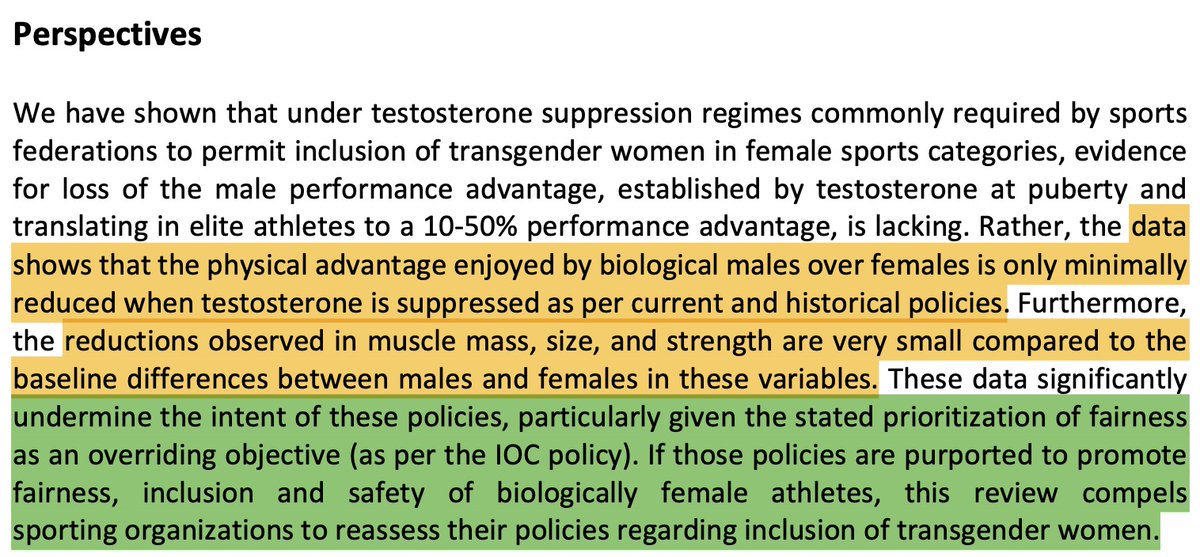Here& #39;s an important paper in the transathlete debate, by @TLexercise & @FondOfBeetles. They ask whether male performance advantages are removed after testosterone suppression? (as required by many sports policies for transwomen to compete) My thoughts (1/ https://www.preprints.org/manuscript/202005.0226/v1">https://www.preprints.org/manuscrip...
To give the answer upfront, they answer the question with a very strong “no”, as per this section in the conclusion (the yellow bit), with the implication highlighted green. To reach this point, they follow a pretty simple path, which i want to summarise briefly if I can:
The argument is set up and developed in 3 steps:
1. What are the biological differences between males & females?
2. What do these biological differences do for performance differences between males and females?
3. What does testosterone reduction to do to 1, and thus 2?
1. What are the biological differences between males & females?
2. What do these biological differences do for performance differences between males and females?
3. What does testosterone reduction to do to 1, and thus 2?
Because of that logic, you can pretty much look only at the papers figures & tables, and you’d have your answers. Let’s begin with question 1 - the biological difference between male and females (pertaining to physical capability), as per Table 1, shown below:
So if one frames them in a direction of what physiology is ‘favourable’, we have:
Higher lean mass, less fat, more muscle mass (especially upper body), higher strength, longer bones & narrower pelvis, ‘better’ tendons, higher cardiovascular parameters. Gaps range from 6% to >80%
Higher lean mass, less fat, more muscle mass (especially upper body), higher strength, longer bones & narrower pelvis, ‘better’ tendons, higher cardiovascular parameters. Gaps range from 6% to >80%
What follows from physiology is performance, leading to Figure 1 and Table 2. Figure 1 shows women’s performance adjusted to 100% and then how much better men are at a range of activities, from running to more complex tasks like bowling & throwing. Male advantage from 10% to >50%
Table 2 takes one example of functional performance - weightlifting, and compares females to males who weigh the same (which means you’re minimizing the effect of mass, which is already substantial as per T1). This shows that for the SAME MASS, males lift 30% heavier than females
Table 2 also shows, strikingly, that a male at 55kg lifts about the equivalent of a female at 69kg - strength varies even for the same mass. It also shows that without the “ceiling” imposed by weight limits, the M vs F gap is even larger - the absolute strongest is 40% stronger
The logic of these foundational comparisons (biology & performance between M and F) is to basically say “Here’s the bar. This is what the policy would have to remove if it was to create fairness in the typical (or relative performance-matched) male transitions into women’s sport"
That bar exists at a biological difference for things like muscle mass, strength, and resultant performance of between 10% and 40%. 40% for strength and power-based sports. Now, they set about looking for research to see if T reduction reduces the male variables by 10% to 40%.
And that brings us to Table 4, which in context created by those previous comparisons, is the key to their paper. It shows that studies reducing T over 12 months or more produce comparatively small reductions in biology & measured performance. Range is 0% to 10%, typically ± 6%
What that effective leaves is a kind of arithmetic. If the original Male advantage in strength based sports is 30%, then 30% minus what T reduction takes away leaves us with a ‘residual’ advantage that was acquired by males as a result of testosterone’s effects in development
Because the start point is say, 30% - 35% (eg weightlifting, muscle mass), and the amount taken away in these variables by T reduction is 10% (optimistically, it’s more often 5 to 7%), it leaves an advantage greater than 20%. And it’s on that basis that this conclusion is reached
What the paper does is aggregate much of the evidence & themes we’ve discussed for the last few years. It shows first why women’s sport exists as a protected category - the biological & hence performance advantages are so large that sport becomes meaningless to females without it
It then challenges the idea that current policy is fit for purpose IF the policy is solely to achieve fairness as measured by performance differences. If the largest part of the performance gap remains, then the policy can’t be said to achieve that. It may be that the policy...
…is unchanged by sports that decide that "performance fairness" is not a priority, weighting other factors high enough to trump the physiology. But certainly, based on current evidence, this paper pushes you into a difficult corner from which to argue that fairness is achieved
Basically, you’d have to argue that women’s sport should be opened to those who have benefitted from testosterone at adolescence, DESPITE the persistence of the advantages it creates, and not that it should happen because there are none left. The scientific evidence compels that
Naturally, there are other elements to this debate - it is, to echo a discussion from earlier today, a complex issue with many agendas and desires and moving parts. But it’s not that “complicated”, at least from the perspective of biological factors and sports performance.
What sports will have to assess is how much advantage they’re prepared to “allow” to remain, or they’ll have to seek additional evidence to show that these numbers in the @TLexercise @FondOfBeetles papers are massive under-estimates that can be side-stepped.
There are, as is so often the case, no “solutions”, only trade-offs, where priorities must be introduced to what is basically a colliding rights issue. The latter creates the complexity, but the biology, laid out in that paper, is much clearer. And that’s the end of this thread!
OK, 2 late additions. First, Figure 1 in the paper, with Table 2 showing how physiology changes with T reduction, lends itself to a possibility that different sports may see different effects & thus different policies. Should be clear that a 6% reduction doesn’t always mean same
And second, this comment & subsequent thread are important. This is a pre-print, which I assume is also in the peer-review process, just not yet. What peer-review will do is audit the studies included, maybe adding others, plus interpretation thereof: https://twitter.com/Scienceofsport/status/1260585043468189703">https://twitter.com/Scienceof...
What pre-print does (and I’ve seen this hugely with the covid-19 stuff) is allow everyone to see it, and it can be a really powerful way to gather together information from more sources than one or two or four people can. So I’ll be interested to track it moving forward! OK, END!

 Read on Twitter
Read on Twitter